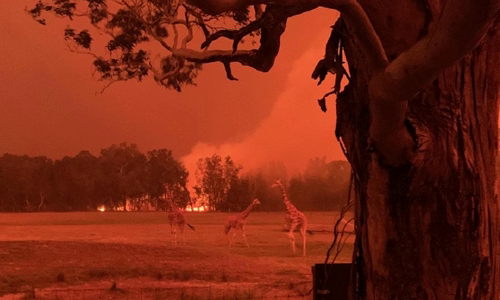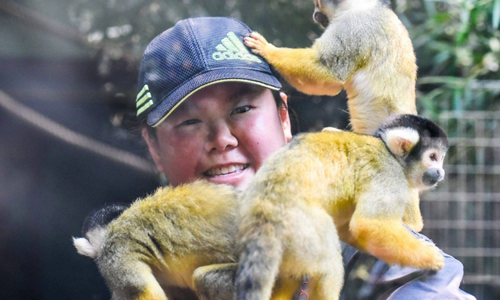Australia While people fled the wildfire in Mogo town, Rachel Yeo drove towards the zoo to save trapped animals.
The government of the town of Mogo, New South Wales (NSW), Australia on New Year's Eve requires people to evacuate urgently, when out-of-control forest fires threaten their lives. However, Rachel Yeo, the zookeeper from Singapore, defied the warning to go to Mogo Wildlife Park, where she worked.

Giraffes roam the grass at Mogo Wildlife Park, NSW, Australia near a fire Photo: The Australian.
"The first thing I thought about was going to the zoo to check the animals. My priority was to make sure they were safe. This was the only journey I had ever taken, because when I drove toward the facility. interesting, everyone runs in the opposite direction, "Yeo recounted.
The 31-year-old woman said the locals were basically in a mental state before the fire spread. "It was really the scariest day of my life. The fire rushed like a giant monster. You could smell smoke, feel the scorching heat and the red hell covered my sight. too stressful, "Yeo described.
Mogo Wildlife Park is home to about 200 animals, including lions, giraffes, zebras and rhinos. Many species are too large or difficult to evacuate safely. The staff did everything they could to protect, protect, and prepare them for the disaster, but the damage from unprecedented large forest fires was inevitable. For a town of only about 300 residents like Mogo, the loss of more than 176 houses and two deaths were devastating losses.
This is just one of many forest fires that have swept across Australia in recent weeks, devastating large areas of forest. NSW was the worst hit state and had to declare a state of emergency in November 2019. At least 28 people were killed across Australia, more than 2,000 houses were destroyed, including 1,588 homes in NSW. More than 7.3 million hectares of land have been burned in six states. According to estimates from biologists, one billion animals may have died.
Yeo has just been working at the zoo in Mogo since early December last year. However, she still treats the animals here, especially the primate children she looks after every day, like her family.
"We have a close relationship with our animals. It's not a skunk or a gibbon, but our close friends. I won't let them suffer in flames," she said. to speak.
Yeo and 14 other staff members guarded the locations around the zoo in response to the disaster, extinguishing small fires as soon as they broke out. However, when the situation began to get complicated, the day seemed to turn into night in the thick smoke, their efforts gradually fell into despair.
"I never thought things could be so bad. The peak condition lasted about three hours, the fire was so serious," said Chad Staples, director of the Mogo zoo. His premises were cornered.

Rachel Yeo and the animals in the zoo in the town of Mogo Photo: CNA
"I can't explain how scary it is. Smoke, ash, debris, the wind swept it all and it felt like a storm. It was only 10 am but I thought it was midnight, in the middle of the night. when I'm completely alone, "said Yeo.
"Every biological instinct tells you to run right away. I can imagine the situation the animals experience," the Singapore woman added. She has sought ways to avoid damage to the zoo, as well as the animals were not hurt.
The danger was finally repelled by the wind of change. On January 15, rainfall of up to 80 mm rained down on states in the Australian wildfire disaster, helping put down 32 fires in NSW. The Australian Bureau of Meteorology forecasts rainfall of 30-80 mm in eastern NSW on January 16-19.
Although the zoo is preserved, many other areas in the town of Mogo, as well as a large area of land on the southern coast, have been devastated, causing people to suffer when losing revenue from the tourism industry. "Now we have to try to attract tourists back. People will suffer because of this with persistent consequences," Staples said.
Not as fortunate as the animals in the zoo, the wild ones have to fight themselves among the flames and suffer heavy damage. "I cried when I thought about too many animals dying from the fire, while the living animals starved to death due to loss of shelter and food sources," Yeo said.
An account on the GoFundMe crowdfunding platform was set up to support the zoo in Mogo after the disaster that raised more than $ 60,000. Staples said the money will be used to build a veterinary hospital to treat countless injured, sick or hungry wildlife. He also plans to replant trees around the area to provide a natural environment for them.
Despite her injuries and worries about the upcoming situation, Yeo said she was empowered by the cohesion of the small community in the town of Mogo, as well as their courage in the face of challenges. "The staff at the zoo are very tolerant and wonderful. Many of them are on duty even if they don't know whether their home and family are safe," she said.
"Everyone tries to contribute. They are really resilient. This is the strong spirit of the Australians," Yeo said.



 JeredQuarles
JeredQuarles







